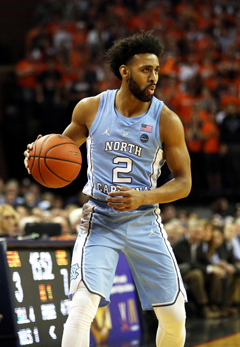Dec 27, 2017Recovery on the Road

With an early stretch of games on the road this season, the men’s basketball squad at the University of North Carolina has been adapting to the grind. Recovery is one of the focal points for the team this year.
An article from InsideCarolina.com explains that the team’s Head Athletic Trainer Doug Halverson, MA, ATC, CSCS, and Strength and Conditioning Coordinator Jonas Sahratian, MS, CSCS, work to get the squad ready. Before games and practices, Halverson and Sahratian lead exercises and help with stretches.
“Doug and Jonas do a good job of getting us ready for each and every game,” said UNC senior forward/guard Theo Pinson. “With us being veterans, we know how our body works and what can get us back going better.”
For the Tar Heels, this includes a three-step process that includes stretching, soft-tissue care, and hydration/fueling. Each step is scheduled for the maximal benefit.
Before a game or practice, the focus is on getting the student-athletes fueled. Afterward, getting re-hydrated is key.
Soft-tissue care comes next, both before and after games or practices. Before a game or workout, the squad uses foam rollers to boost blood flow and engage the central nervous system. In turn, this improves flexibility and range of motion, reduces pain, and helps muscles.
After practices or games, the squad uses contrast therapy. The Tar Heels alternate between hot and cold tubs to force muscle tissues to adapt to sudden changes. This stimulation helps to reduce swelling and soreness.
“It is a lot of the contrast — hot tub, cold tub stuff,” said UNC junior guard Kenny Williams. “I’ll start in the hot and go cold, hot, cold, hot, cold.”
After a win over the University of Michigan earlier this year, UNC junior forward Luke Maye was eager to start this form of recovery.
“I am going to go get in the cold tub here in a minute,” Maye told reporters. “I think a lot of guys do that, especially guys that play extended minutes. We’ve just got to recover tomorrow.”
The soft-tissue focus includes more than foam rollers and contrast therapy, though. The Tar Heels also use alternative therapies.
“We have a lot of things,” Williams said. “Doug and Jonas make sure our legs are right. We do the cupping, the NormaTec.”
Cupping involves suction to help blood flow and reduce inflammation and to act as a form of deep-tissue massage. The NormaTec device molds around the legs to encourage rapid recovery through a pulsed massage.
“It just compresses and stops the blood flow. It lets go and then gets the blood flowing again,” Williams said. “You can do it however long you want, really. I usually do it 20 to 30 minutes.”
Although coordinating resources to use on the road can be a challenge, Halverson and Sahratian have it down to a science.
“I think our team does a great job and our strength and conditioning coach and our [athletic] trainer do a good job of setting up recovery times for us to come and get our legs right,” said UNC senior guard Joel Berry. “When we went to the PK80 Tournament, they did a great job of taking us to the cold plunging where we were able to do the hot tub/cold tub and able to do the steam room. They do a great job of being able to find resources to keep our legs together and keep our bodies moving.”



